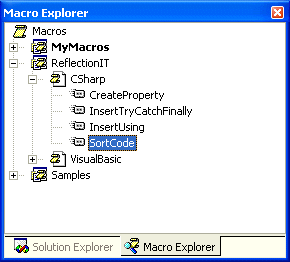On November 7th, at the OOPSLA Conference in Seattle, WA, C# creator Anders Hejlsberg unveiled several potential language features for the next major release of Visual C# .NET. The four primary features Anders spoke about were:
-
Generics, a form of C++ templates that makes reusing existing code easier
-
Iterators, a construct that makes traversing collections of data significantly faster and easier
-
Anonymous methods, an easier way to perform simple tasks using delegates
-
Partial types, a means for programmers to split code across multiple files
Read more
The System.Windows.Forms.Form class has an AcceptButton property which can be used to set the button on the form that is clicked when the user presses the ENTER key. The accept (default) button should be the button that represents the action that the user is most likely to perform if that action isn't potentially dangerous. This button has a dark border to let the user know that it is the accept button.
This feature works great only when you have one accept button. Have a look at the following diaglog.

The OK button is in this dialog the accept button. This is the correct behavior when the textbox 'Name' and datepicker 'Date' have the focus. There should not be an accept button when the (multiline) textbox 'Description' has the focus. When listbox 'Avialiable' has the focus the '> Add >' button must be the accept button. And when listbox 'Assigned' has the focus the '> Add >' button must be the accept button.
This can be accomplished by implementing the following Enter and Leave event handlers.
I have used the Janus GridEX control in many of my VB6 projects. It worked perfectly and it is very fast.
I have tested the .NET Trial version, it is even better. This is a component that everybody who is building WinForms application should buy.
Have a look at Janus GridEX Control for .NET and try it yourself.
You should write your code in a consistent style. This is easier said then done. The SortCode macro helps you with this by sorting your C# code.
The SortCode macro sorts all members of a type (class or struct) on alphabetical order grouped by their type.

The default order of the types is:
- Events
- Fields
- Enums
- Constructor
- Destructor
- Properties and Functions
- Properties and Functions of implemented interfaces
I find Regular Expression powerful but difficult. Eric Gunnerson wrote the Regular Expression Workbench. This makes them easy.
It's a tool to create, test, and study regular expressions with this workbench. With the "Examine-o-matic" feature, hover over the regex to decode what it means
I have found a class that allows for balloon shaped forms in .NET.
Have a look at CodeProject.
What happened with the XML WebServices Award on the GotDotNet website? I have submitted my Html2Xml webserivce. I don't expect to win the 25.000 dollar price, an X-box would be nice :-)
The winners would be announced at the Teched in Barcelona (1-5 July 2002). Then this was moved to July 12. It is now August. Nothing has happened. Is there no winner?
Strange!
Most commercial WinForm applications have a SplashScreen. This article explains how you can implement one using the Microsoft .NET Framework.

Example: Visual Studio.NET SplashScreen
I have found the opensource project/tool NDoc which compiles the C# Xml Documentation to MSDN like help file.
It works great!
I don't like COM+. I have never liked it but I had to use it when I needed Distributed Transactions. At the Teched 2002 in Barcelona I learned how you can use Distributed Transactions without COM+.
My problem with COM+ is the fact that you only can choose one transactiontype for a class. You can not differentiate it per method.
Download the following Zip file and have a look at Ron Jacobs example project and slides.
Be carefull, this only works on Windows XP. It uses some lowlevel COM+ 1.5 features.


